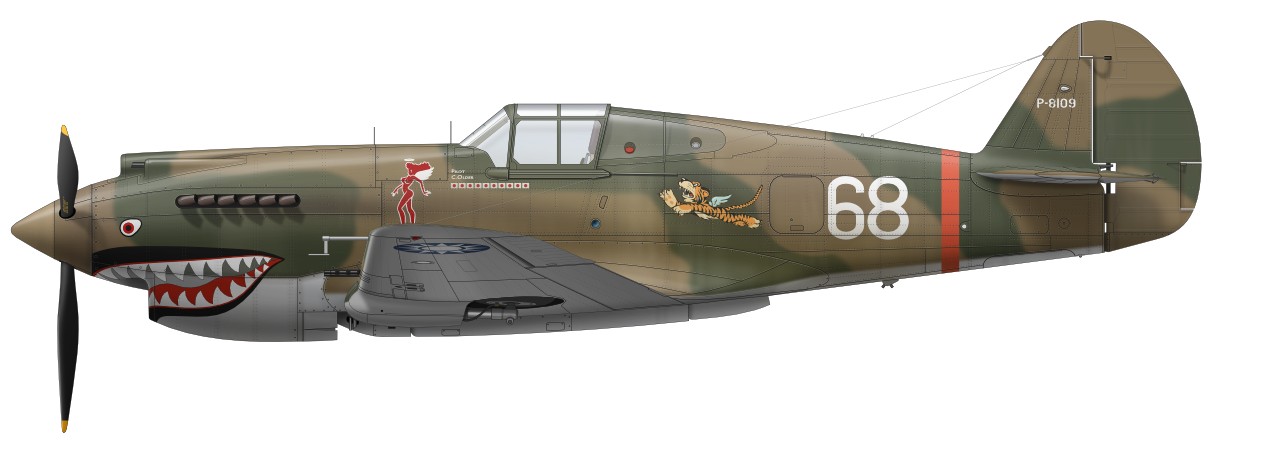
Curtiss P-36 P-40 series drawings
 |
|
Prior to the construction, I made drawings of P-36 and P-40 Series. When I made my drawings, I used a set of Curtiss's factory drawings and the Structural Repair Instructions manual. I carefully read factory drawings and manual, checked photos of actual aircfart, then I translated them into my drawings.
|
Total Length (inches)
| D&S | WA | IA(1) | IA(2) | EMI | FD | |
| P-36 | 342 | - | - | - | - | 346.12 |
| P-40B/C | 381 | - | 380.56 | 380 | - | 381.6 |
| P-40D/E | 374 | 380.5 | 380.72 | 374 | 380.75(*) | 380.72 |
| P-40F-1 | 380.72 | - | - | - | - | 380.47 |
| P-40F-5/L | 399.72 | - | 401.72 | 400 | - | 400.47 |
| P-40M/N | 399.72 | - | 401.72 | 400 | 399.72 | 400.72 |
D&S : Details & Scales, WA : Walk Around, IA(1) : In Action 1026, IA(2) : In Action 1205, EMI : Erection And Maintenance Instructions, FD : Estimation by Factory Drawings from AirCorps Library (*) : P-40K |
|
Lengths in the column FD of the table are based on factory drawings, and I believe these lengths are the nearest to the truth. Well, I'd explain the reason. The most reliable length is the short body model of P-40D/E/K. Each length written in general three view drawings, cowl assembly drawing, fuselage assembly drawing of factory drawings are equivalent. Values are 118-3/8" from the firewall (sta 0) to the tip of the spinner, 262-11/32" from the firewall to the rudder rear end, totaling 380-23/32" = 380.72" = 9,670 mm. The short body K model is the same as the D/E model. It is certain that M/N model of long body Warhawk is just 20" longer than the short body model judging from the fuselage assembly drawing (the station value of the ladder hinge). Thus the total length is 400-27/32". However,the general three view of factory drawings made a mistake as total length 399-27/32". The individual lengths in this figure are correct but the total sum are not match. And I guess that the EMI manual quoted from this general drawings. Next, as for Merlin model F/L, general three view are not included in the factory drawing. However, there are cowl assembly drawings which clearly shows that the cowl of F/L model is 1/4 "shorter than the Allison model D/E. The length of spinner and rearward fire wall are the same. Thus, the total length of Merlin model should be 0.25" shorter than Allison model. Subsequently, P-36 (or H-75, both are the same). There is the general three rview in the factory drawings, and the total length including the spinner is described. However, it is slightly different when superimposed with the side view photo of the actual aircraft.I guess the spinner may be the reason of this diference. The rear fuselage after the fire wall is confirmed to be the same length as P-40D/E by the fuselage structure drawings. Thus the rear fuselage of P-40B is also the same as P-40D/E. Finally, the total length of P-40B. Actually, factory drawings from "AirCorps Library.com" don't include any B/C model drawings. But according to the factory drawings of B model nose from other source,the rear end of the spinner station is -92-13/16". The length of the spinner can be calculated from side view photos. Then the station of the spinner tip is estimated -119.3". The fuselage length after the fire wall is 262-11/32" = 262.34". Thus, the total length is estimated 381.6" (rounded to significant figures).
|

|
|

|
P&W Twin Wasp R-1830 valiant P-36A fuselage guns 0.50x1 0.30x1, no wing gun, 178 production P-36C wing guns 0.30x2 wad added 32 production P-36G wing guns was changed to 0.30x4. renamed from H75A-8 30 production H75A-1 fuselage guns 7.5mmx2, wing guns 7.5mmx2, originally orderd by France, obtained by the RAF when France fell and named Mohawk I 100 production H75A-2 fuselage guns 7.5mmx2, wing guns 7.5mmx2(x4 48th and later a/c), originally orderd by France, obtained by the RAF when France fell and named Mohawk II 100 production H75A-3 fuselage guns 7.5mmx2, wing guns 7.5mmx4, originally orderd by France, obtained by the RAF when France fell and named Mohawk III 135 production H75A-6 fuselage guns 7.5mmx2, wing guns 7.5mmx4, deliverde to Norway, Thirteen captured by the Germans who provided eight to Finland 24 production Wright Cyclone R-1820 valiant H75A-4 fuselage guns 7.5mmx2, wing guns 7.5mmx4, originally orderd by France, obtained by the RAF when France fell and named Mohawk IV 284 production H75A-7 fuselage guns 7.5mmx2, wing guns 7.5mmx4, orderd by Holland, but Holland fell before delivery, provided to the Dutch Indies 20 production H75A-9 fuselage guns 7.5mmx2, wing guns 7.5mmx4, diverted to RAF as Mohawk IV, then transferred to India 10 production * quoted from D&S(other than A-1,-2), Curtiss manual for French Air Force(A-1,A-2) https://web.archive.org/web/20150924021036/http://www.gc2-4.com/NSGAcouv.htm https://web.archive.org/web/20150924021030/http://www.gc2-4.com/NMACcouv.htm The P-36A which was first deployed on the USAF has 0.50 (starboard) and 0.30 (port) fuselage guns. There is no wing machine gun. This model was encountered Pearl Harbor attack. Only one aircraft of P-36B was producted. The following P-36C added 0.30x2 guns to the wing. P-36A and some C model had no exhaust fairing. Some C model has the fairing. It is unknown whether it is retrofitted, or removed, or introduced at the middle production of C. The spinner is step type. P-36G was ordered by Norway as H75A-8, and taken over to the US by the surrender of Norway and sent to the training unit. There are slits on the fuselage machine gun panel which is a feature of export model H75A. Export model is different from USAF model such as fuselage gun slits, pitot tube, antenna, gunsight and so on. France was ordered H75A-1 to -4. H75A-1,-2 and -3 equipped P&W Twin Wasps, H75A-4 equipped Wright Cyclone. Each model had different wing guns. H75A-1 and -2 had no fuselage gun slits. Due to the surrender of France, part of them was handed over the RAF and was named Mohawk. The spinner of them was mostly step type. Some late model has shell shape spinner. Part of H75A-6 was sent to Finland. Cyclone engine model was also seen in the Finnish air force but its history is unknown.
|
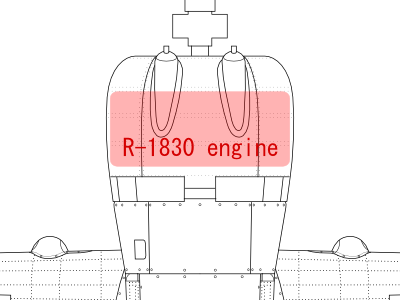 The engine cowl top view shape was drawn as to take the necessary clearance from Twin Wasp R-1830 engine (diameter 1,220 mm). When it was drawn as the coordinate table of the factory drawing, the side line from the engine cowl to firewall did not connect smoothly. |
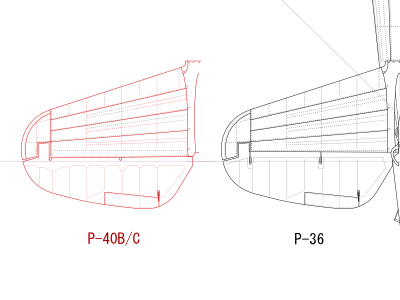 The horizontal stabilizer rear end line is different from P-40. The hinge position is the same, the elevator of P-36 is extended forward. There are two curved stays that support the hinge tube of the elevator. |
Port Aileron tab of the RAF Tomahawk including Flying Tigers's H81A-2 is fixed type. On the other hand, the USAF model is movable. In the late production of C model, the tail gear legs is longer, and the rear end is cut off. |
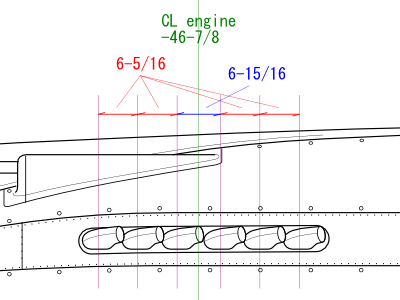 |
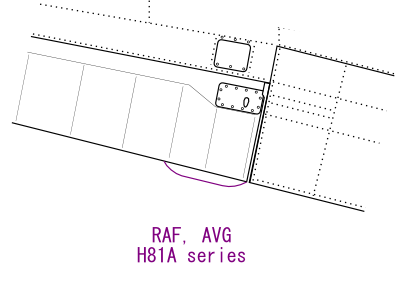 |
|
|
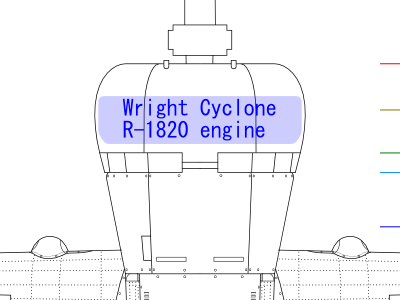 The maximum diameter of the engine is in front of the cylinder and the rear half is narrow. |
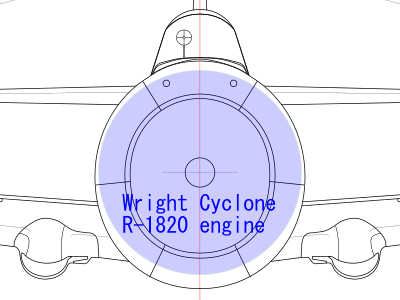 The diameter of Cyclone R-1820 engine is 1,378mm. There are spaces of air ducts at the top and bottom. The machine gun should pass between the cylinders. |
|
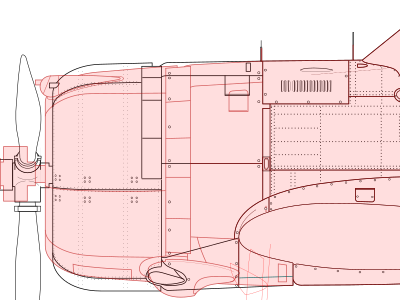 It is compared with Twin Wasp P-36 in the side view. The total length due to engine differences is not so different as Wildcat. |
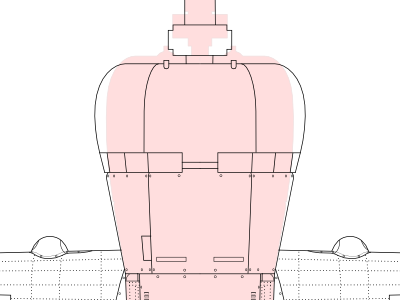 I guess that the accessory cowl must be wider than P-36. |
|
I'd show side view photo which was errcorrected perspective error. Sources are reference -39. The step of the silhouette is not the step of the fuselage but the gear fairing. Don't make a quick judgment. I'd also try to overlap with FM-2. |
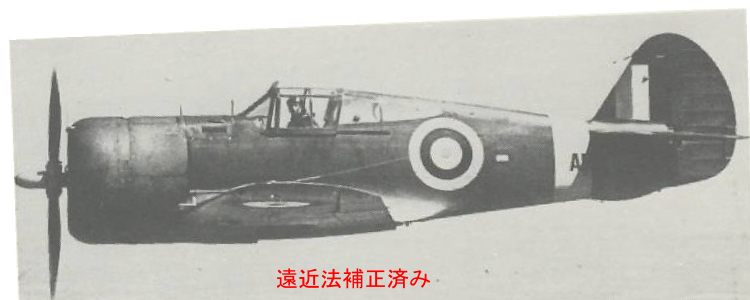 |
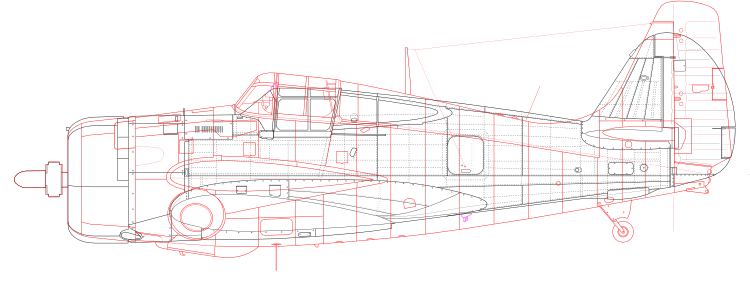 |
|
|
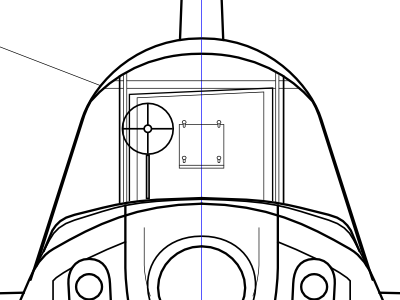 Expansion of front view. Bulletproof glass fits into a metal frame. The metal fixture is omitted in this drawing. |
|
Anyway, I list up fixed gear Hawks below. H75M fuselage 0.50x2 wing 0.30x4 ordered by China 30 production H75N fuselage.50x2 wing 0.30x2 ordered by Thailand production number unknown, some aircraft mounted 23mm gun under the wing H75O fuselage.50x2 wing 0.30x2 ordered by Argentina 29 production, additional 20 built in Argentina H75H, Q are both only 2 were producted. H has different shape gear fairing, curved windshield. Some references describe that H75Q has retractable gear.
|
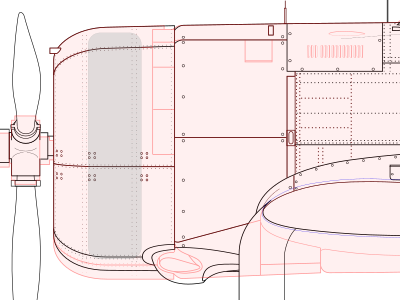 Black lines are fixed gear model, red lines are a retractable Cyclone model, grey is a Cyclone R-1820 engine of fix gear model. |
|
The shape of the windscreen composed of flat glasses is determined as follows. First of all, I considered a triangle (light blue) with extending the front, back, and bottom sides of the side window. The angle of inclination of the front window is the same angle as the curved glass type. It can be seen from the photo of the actual aircraft. Then I confirmed with a supplementary line of 45° so that three vertices of the triangle do not contradict each other in each drawing. Since the shape of the windscreen rear frame is the same as the slide hood, the two points of the triangle are fixed, and forward point is moved and searched where the shape of the front window looks like photo of actual aircraft. The result is shown below. It should not be "drawings which can not be built". Since the side window is narrowing forward, the top view shape of the lower fairing is also different from other models. The fixed gear type might be planned knockdown production and easy to manufacture. |
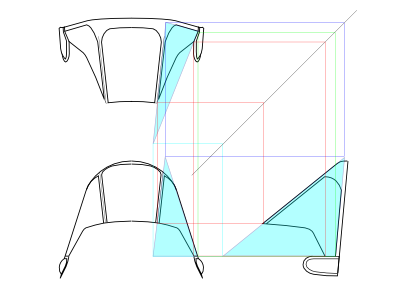 |
|
|
| 1 | Erection And Maintenance Instruction P-40E/K/M/N model | - | - |
| 2 | The World Famous Airplane of the World No.39 P-40 Warhawk (New Eddition) | - | Bunrin-Do |
| 3 | The World Famous Airplane of the World P-40 Warhawk (Old Eddition) | - | Bunrin-Do |
| 4 | Curtiss P-40 In Action aircraft no.26 | 0-89747-025-7 | Squadron/Signal Publications |
| 5 | P-40 Warhawk In Action aircraft no.205 | 0-89747-537-2 | Squadron/Signal Publications |
| 6 | Walk Around P-40 Warhawk Walk Around Number 8 | 0-89747-361-2 | Squadron/Signal Publications |
| 7 | D&S Vol.61 P-40 WARHAWK PART 1 Y1P-36 through P-40C | 1-888974-14-1 | Squadron/Signal Publications |
| 8 | D&S Vol.62 P-40 WARHAWK PART 2 P-40D through XP-40Q | 1-888974-15-X | Squadron/Signal Publications |
| 9 | P-40 Warhawk In Color Photos from World War II | 0-87938-928-1 | Motorbooks International |
| 10 | Eagle Files 4 Tigers Over China The Aircraft of the A.V.G. | 0-966076-7-4 | Eagle Editions |
| 11 | Flying Tigers American Volunteer Group | 3-912749-03-04 | DTU |
| 12 | Miniatury Lotnicze 22 112 Sqn "Shark Squadron" 1942-1945 | 83-89088-75-4 | Kagero Studio |
| 13 | Miniatury Lotnicze 28 AVG "Flying Tigers" 1941-1943 | 83-89088-28-2 | Kagero Studio |
| 14 | Monografie 36 Curtiss P-40 vol.1 | 978-83-60445-27-3 | Kagero Studio |
| 15 | Monografie Lotnicze 61 Curtiss P-36 Hawk cz.1 | 83-7237-036-2 | AJ-Press |
| 16 | Monografie Lotnicze 62 Curtiss P-36 Hawk cz.2 | 83-7237-037-0 | AJ-Press |
| 17 | Monografie Lotnicze 63 Curtiss P-36 Hawk cz.3 | 83-7237-038-9 | AJ-Press |
| 18 | Monografie Lotnicze 64 Curtiss P-40 cz.1 | 83-7237-039-7 | AJ-Press |
| 19 | Monografie Lotnicze 65 Curtiss P-40 cz.2 | 83-7237-040-0 | AJ-Press |
| 20 | Monografie Lotnicze 66 Curtiss P-40 cz.3 | 83-7237-041-9 | AJ-Press |
| 21 | Aircraft of the Aces 35 P-40 Warhawk Aces of the CBI | 1-84176-079-X | Osprey Publishing |
| 22 | Aircraft of the Aces 38 Tomahawk and Kittyhawk Aces of the RAF and Commonwealth | 1-84176-083-8 | Osprey Publishing |
| 23 | Aircraft of the Aces 41 American Volunteer Groups Colours and Markings | 1-84176-224-5 | Osprey Publishing |
| 24 | Aircraft of the Aces 43 P-40 Warhawk Aces of the MTO | 1-84176-288-1 | Osprey Publishing |
| 25 | Aircraft of the Aces 55 P-40 Warhawk Aces of the Pacific | 1-84176-536-8 | Osprey Publishing |
| 26 | Aircraft of the Aces 86 P-36 Hawk Aces of World War 2 | 978-1-84603-409-1 | Osprey Publishing |
| 27 | Aircraft of the Aces 117 Aces of the 325th Fighter Group | ISBN 978-1-78096-302-0 | Osprey Publishing |
| 28 | Aviation Elite 14 49th Fighter Group Aces of the Pacific | 1-84176-785-9 | Osprey Publishing |
| 29 | Aviation Elite 31 23rd Fighter Group 'Chennault's Sharks' | ISBN 978-1-84603-421-3 | Osprey Publishing |
| 30 | Aviation Elite 39 57th Fighter Group 'First in the Blue' | 978-1-84908-337-9 | Osprey Publishing |
| 31 | Osprey Duel 8 P-40 Warhawk vs Ki-43 Oscar | 978-1-84603-295-0 | Osprey Publishing |
| 32 | Osprey Duel 38 P-40 Warhawk vs Bf109 MTO 1942-44 | 978-1-84908-469-7 | Osprey Publishing |
| 33 | Checkertails The 325th Fighter Group in the Second World War | 0-89747-316-7 | Squadron/Signal |
| 34 | 49th Fighter Group | 0-89747-221-7 | Squadron/Signal |
| 35 | The Curtiss P-36 and P-40 in USAAC/USAAF service 1939 to 1945 | 0-9539040-5-9 | Guideline Publications |
| 36 | Red Series 5112 Curtiss Hawk-75 in French Service | 978-83-61421-07-8 | Mushroom Model Publications |
| 37 | Red Series 5104 Fighters Over France and the Low Countries | 83-916327-1-7 | Mushroom Model Publications |
| 38 | Les Ailes de Gloire No.6 Curtiss Hawk H75 | 2-914403-08-9 | Editions d'Along |
| 39 | Curtiss Hawk 75 | - | Ducavia |
| 40 | Suomen Ilmavoimien Historia 5 Curtiss Hawk 75 P-40M | 951-98751-9-0 | Kari Stenman Publishing |
| 41 | RAAF Camouflage & Markings 1939-45 Vol1 | - | Kookaburra Technical Publications |
| 42 | RAAF Camouflage & Markings 1939-45 Vol2 | 0-85880-037-3 | Kookaburra Technical Publications |
| 43 | The P-40 Warhawk, Mustang and Kittyhawk in Australian service | 0-9587978-1-1 | Aerospace Publications |
| 44 | Aircraft Pictorial No.5 P-40 Warhawk | 978-0-9817931-1-5 | Warships Publishing |
| 45 | Aviatic WWII Aircraft No.1 Curtiss P-40F Warhawk | - | Aviatic |
| 46 | Air Vanguard 8 Curtiss P-40 Long-nosed Tomahawks | 978-1-78096-909-1 | Osprey Publishing |
| 47 | Air Vanguard 11 Curtiss P-40 Snub-nosed Kittyhawks and Warhawks | 978-1-78096-912-1 | Osprey Publishing |